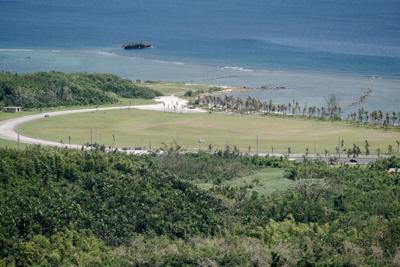It's more than just a road. "It is a pathway connecting key historical and cultural landmarks" that are significant to Guam's brutal wartime occupation.
Bill 170-38, introduced by Speaker Frank Blas Jr., would rename Route 6 as the "World War II Survivors Memorial Highway" in a continued effort to honor the enduring strength and sacrifices of the people of Guam, he said.
“This legislation recognizes the men, women and children of Guam who lived through the atrocities of World War II, many of whom endured unimaginable hardship, suffering and loss," Blas said. "Their courage and resilience deserve lasting recognition.”
Route 6 begins at the intersection with Route 1, Marine Corps Drive, in Piti, passes through Nimitz Hill and the Asan Bay Overlook Memorial, and reconnects to Route 1 across from the Ricardo J. Bordallo Governor's Complex in Adelup.
According to the bill, Route 6 winds through areas of historic and strategic military importance that played a key role during and after the liberation of Guam in 1944.
In particular, the measure notes that the road passes the Asan Bay Overlook Memorial, in which 15,891 survivors of the Japanese occupation are listed on a memorial wall, adding relevance to the renaming of the roadway.
“This designation ensures that every person who travels this highway remembers the legacy of survival, sacrifice and hope,” said Blas. “It also reaffirms our collective responsibility to preserve and share the history of our survivors with future generations.”
The bill states that Guam was invaded by the Imperial Japanese Army and Navy on Dec. 8, 1941, and remained under Japanese occupation until its liberation by U.S. forces on July 21, 1944.
This period was marked by severe hardship for the indigenous CHamoru people, many of whom were subjected to forced labor, imprisonment, starvation and cruel acts of violence, according to the bill.
Currently, Route 6 is known as Spruance Drive within the village of Piti and Halsey Drive within the village of Asan-Maina.
Raymond A. Spruance and William Halsey Jr. were U.S. Navy admirals who served in the Pacific theater during World War II.
According to the navy.mil website, Rear Adm. Spruance commanded a cruiser division with two aircraft carriers during the Battle of Midway, and his decisions were important to the outcome of the battle, which changed the course of the war with Japan.
Also, according to the website, Adm. Halsey was a highly decorated commander of the Third Fleet and Western Pacific task forces that, beginning in August 1944, "left a trail of enemy ruin and destruction in the Palaus, Philippines, Formosa, Okinawa and the South China Sea, inflicting greater loss upon the Japanese fleet than had ever been suffered by any fleet."
The bill also authorizes the installation of commemorative signage for the renaming, in collaboration with the Department of Public Works.


